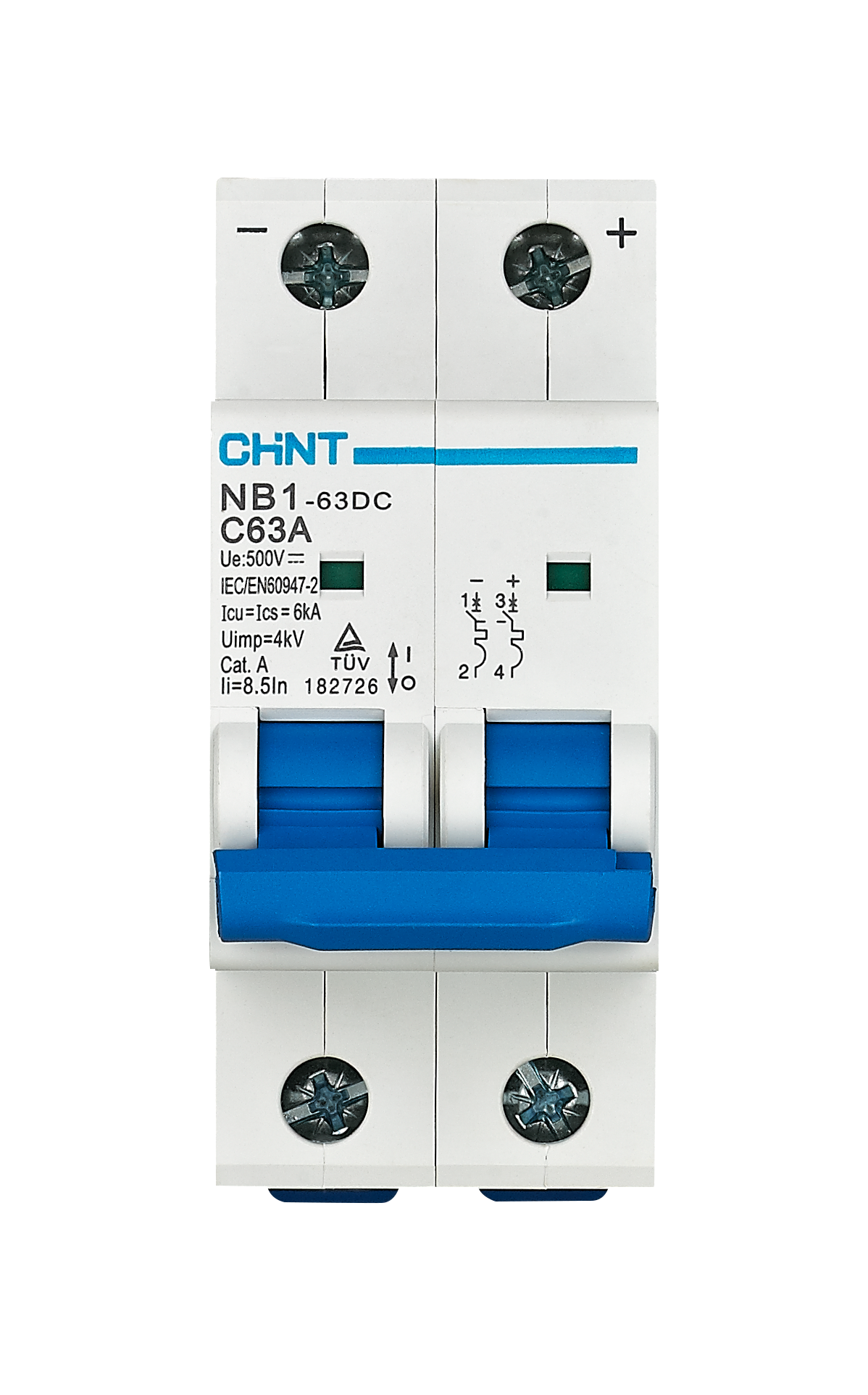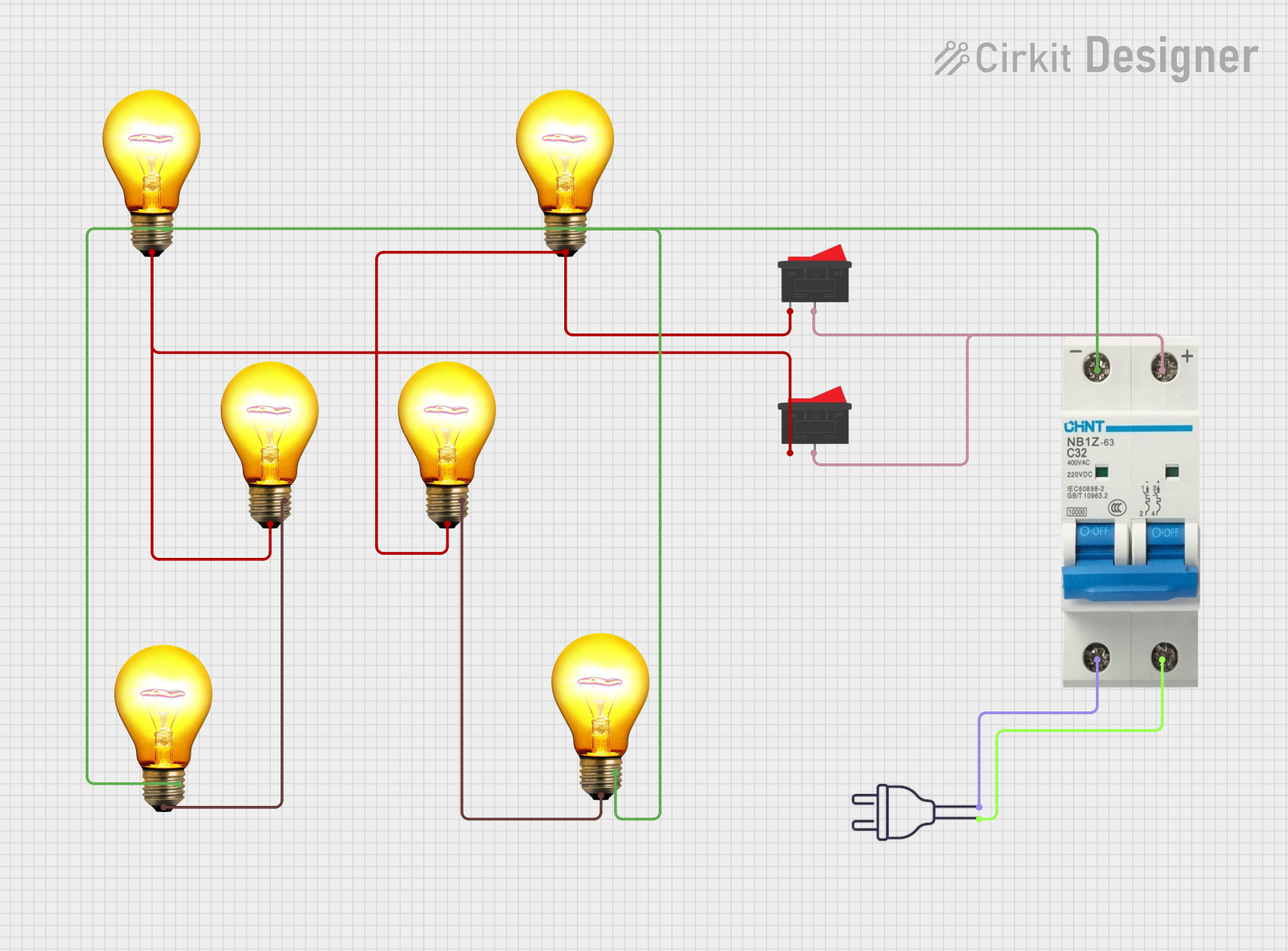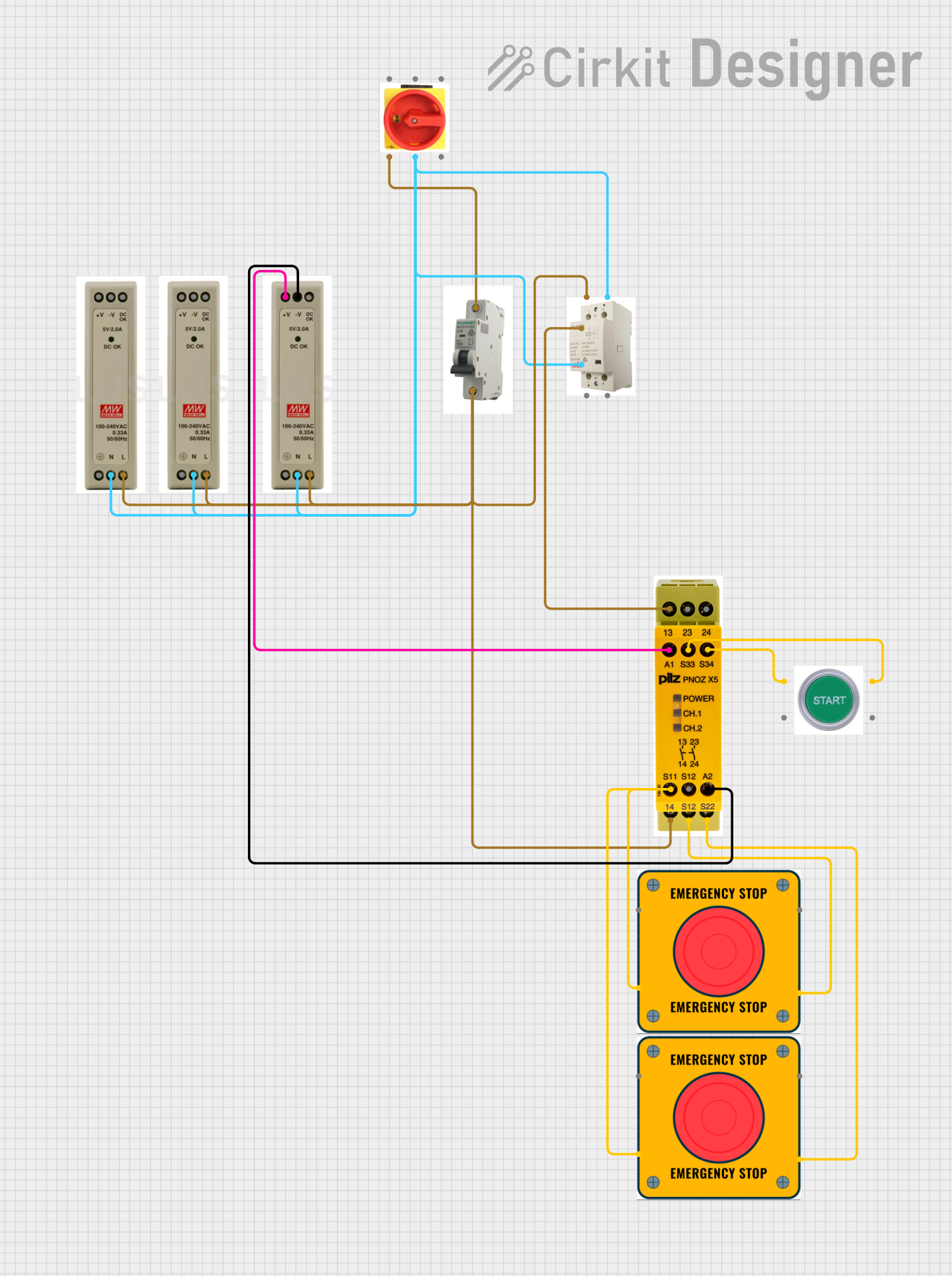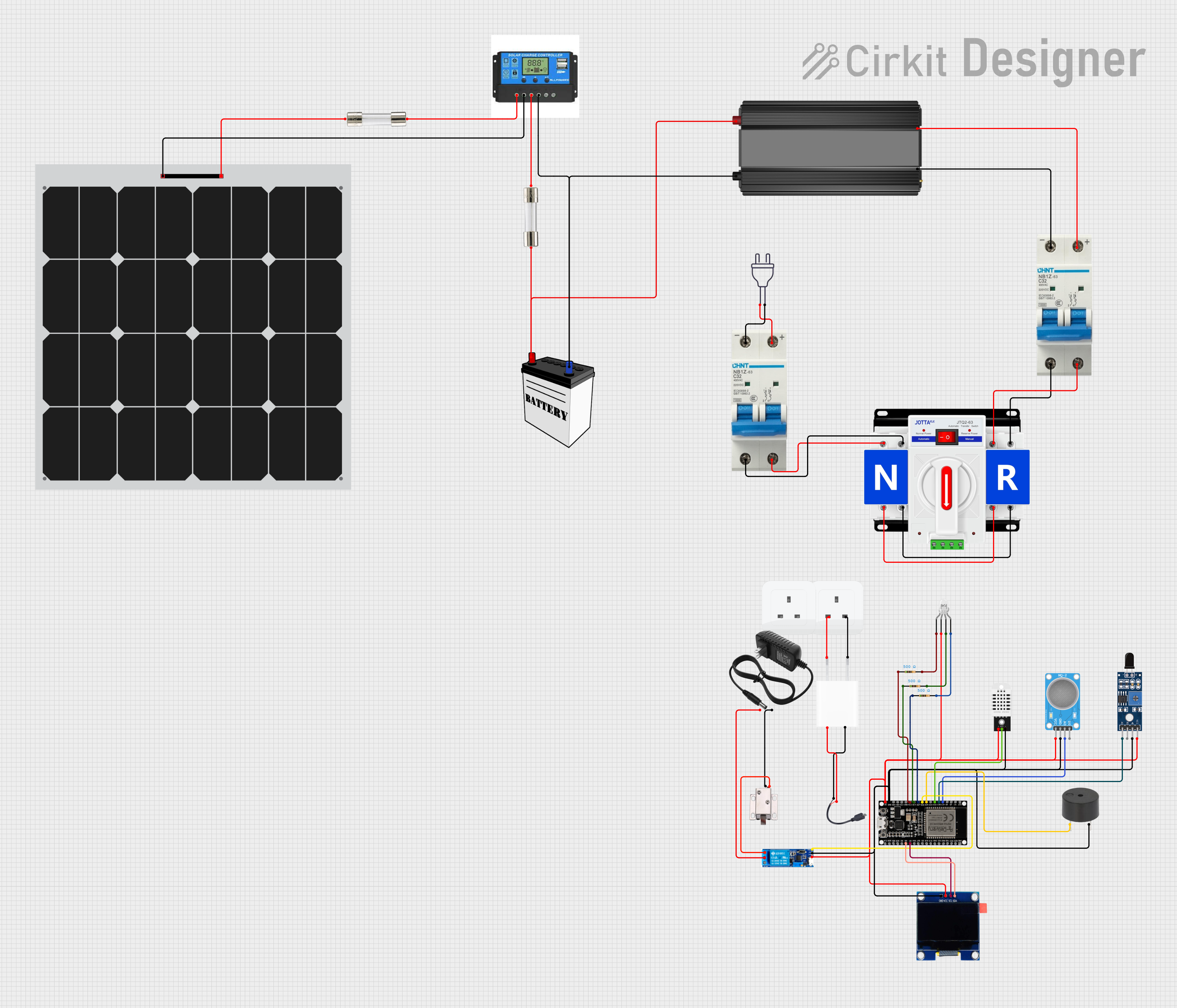
How to Use 2P Breaker: Examples, Pinouts, and Specs

 Design with 2P Breaker in Cirkit Designer
Design with 2P Breaker in Cirkit DesignerIntroduction
A 2-pole circuit breaker (commonly referred to as a 2P breaker) is an essential safety device designed to protect electrical circuits from overloads and short circuits. It operates by automatically disconnecting power when it detects a fault condition, preventing damage to equipment and reducing the risk of fire or electrical hazards.
2P breakers are widely used in residential, commercial, and industrial electrical systems where two-phase or 240V circuits are present. They are particularly suited for applications such as powering large appliances, HVAC systems, and other high-power devices.
Explore Projects Built with 2P Breaker

 Open Project in Cirkit Designer
Open Project in Cirkit Designer
 Open Project in Cirkit Designer
Open Project in Cirkit Designer
 Open Project in Cirkit Designer
Open Project in Cirkit Designer
 Open Project in Cirkit Designer
Open Project in Cirkit DesignerExplore Projects Built with 2P Breaker

 Open Project in Cirkit Designer
Open Project in Cirkit Designer
 Open Project in Cirkit Designer
Open Project in Cirkit Designer
 Open Project in Cirkit Designer
Open Project in Cirkit Designer
 Open Project in Cirkit Designer
Open Project in Cirkit DesignerTechnical Specifications
Below are the key technical details of a typical 2P breaker:
| Parameter | Specification |
|---|---|
| Rated Voltage | 240V AC |
| Rated Current | 10A, 20A, 30A, 40A, 50A (varies by model) |
| Number of Poles | 2 |
| Interrupting Capacity | 10kA at 240V AC (varies by model) |
| Trip Mechanism | Thermal-magnetic |
| Mounting Type | DIN rail or panel mount |
| Operating Temperature | -20°C to 60°C |
| Compliance Standards | IEC 60898, UL 489, or equivalent |
Pin Configuration and Descriptions
The 2P breaker does not have traditional "pins" like electronic components but instead features terminals for connecting wires. Below is a description of the terminals:
| Terminal | Description |
|---|---|
| Line 1 (L1) | Connects to the first phase of the incoming power supply. |
| Line 2 (L2) | Connects to the second phase of the incoming power supply. |
| Load 1 | Connects to the first phase of the outgoing circuit (protected load). |
| Load 2 | Connects to the second phase of the outgoing circuit (protected load). |
Usage Instructions
How to Use the 2P Breaker in a Circuit
- Determine the Load Requirements: Ensure the breaker’s rated current matches the load requirements of your circuit. For example, use a 20A breaker for a circuit with a maximum load of 20A.
- Turn Off Power: Before installation, disconnect power to the circuit to avoid electrical shock.
- Connect the Wires:
- Connect the incoming power supply wires to the Line 1 (L1) and Line 2 (L2) terminals.
- Connect the outgoing load wires to the Load 1 and Load 2 terminals.
- Secure the Breaker: Mount the breaker onto a DIN rail or panel as per the installation requirements.
- Test the Circuit: After installation, turn on the power and test the breaker by manually tripping it to ensure it disconnects the circuit properly.
Important Considerations and Best Practices
- Select the Correct Breaker: Always choose a breaker with the appropriate voltage and current ratings for your application.
- Avoid Overloading: Do not exceed the breaker's rated current, as this can cause nuisance tripping or damage.
- Regular Maintenance: Periodically inspect the breaker for signs of wear, corrosion, or damage.
- Proper Wiring: Ensure all connections are secure and that the wire gauge matches the current rating of the breaker.
Example: Connecting a 2P Breaker to an Arduino-Controlled Circuit
While a 2P breaker is not directly interfaced with an Arduino, it can be used to protect circuits controlled by an Arduino. For example, if an Arduino is used to control a high-power motor, the 2P breaker can be installed between the power source and the motor to provide overload protection.
// Example Arduino code to control a motor via a relay
// Ensure the motor circuit is protected by a 2P breaker
const int relayPin = 7; // Pin connected to the relay module
void setup() {
pinMode(relayPin, OUTPUT); // Set relay pin as output
digitalWrite(relayPin, LOW); // Ensure relay is off at startup
}
void loop() {
// Turn on the motor
digitalWrite(relayPin, HIGH); // Activate relay to power the motor
delay(5000); // Run motor for 5 seconds
// Turn off the motor
digitalWrite(relayPin, LOW); // Deactivate relay to cut power
delay(5000); // Wait for 5 seconds before restarting
}
Note: The 2P breaker should be installed on the power supply line to the motor, not directly in the Arduino circuit.
Troubleshooting and FAQs
Common Issues and Solutions
| Issue | Possible Cause | Solution |
|---|---|---|
| Breaker trips frequently | Overloaded circuit | Reduce the load or use a breaker with a higher current rating (if appropriate). |
| Breaker does not trip during a fault | Faulty breaker or incorrect installation | Inspect the breaker and ensure proper wiring. Replace if necessary. |
| Breaker cannot be reset | Internal damage or persistent fault | Check for short circuits or replace the breaker if damaged. |
| Breaker feels hot during operation | Loose connections or high ambient temperature | Tighten connections and ensure proper ventilation. |
FAQs
Can I use a 2P breaker for single-phase circuits? Yes, a 2P breaker can be used for single-phase circuits by connecting only one pole, but this is not recommended unless specified by the manufacturer.
What is the difference between a 2P breaker and a 1P breaker? A 2P breaker protects two-phase circuits (e.g., 240V) and disconnects both phases simultaneously, while a 1P breaker protects single-phase circuits (e.g., 120V).
How do I know if my breaker is faulty? If the breaker trips without a load, cannot be reset, or shows visible damage, it may be faulty and should be replaced.
Can I install a 2P breaker myself? Installation should be performed by a qualified electrician to ensure safety and compliance with local electrical codes.